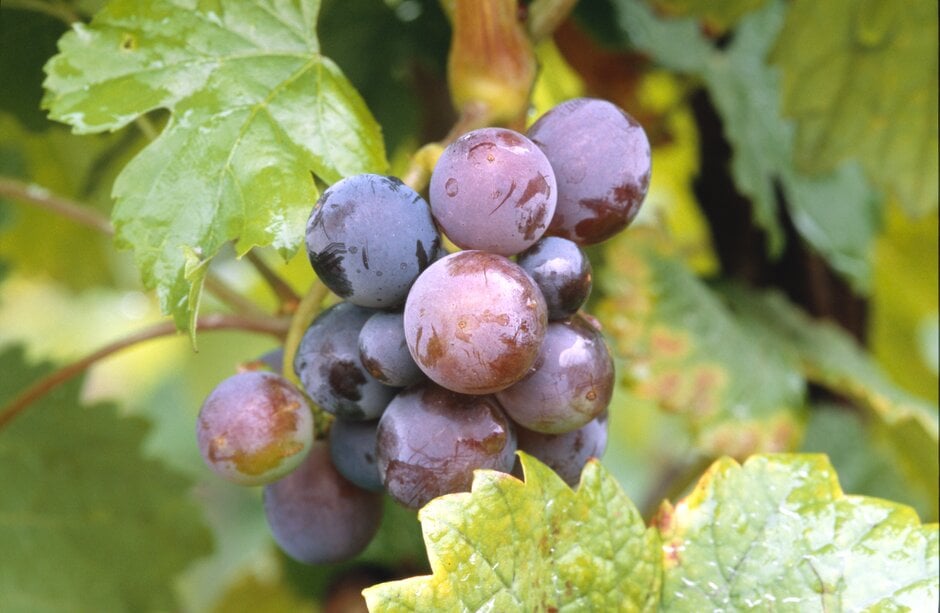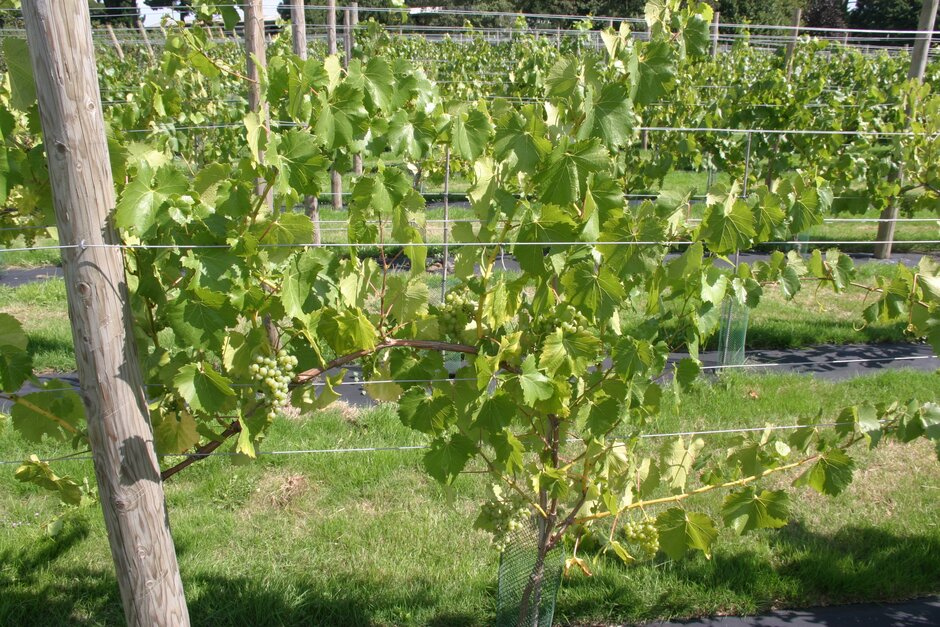Grapes: training as a standard
If you only have limited space in the garden or greenhouse, a grapevine can be grown in a container and trained into a compact form known as a standard.

Quick facts
- Ideal where space is at a premium
- Best for dessert grapes, indoors or outdoors
- Grow the vine in a large container
Jump to
What is a standard?
A ‘standard’ is a trained form, in which the plant is pruned so it has a clear main stem and a rounded ‘head’ of branches at the top, like a lollipop. A wide range of plants can be trained this way, from roses to bay trees.
Standard-trained grapevines are usually grown in large containers and although they will only produce a modest crop, they make a decorative feature and are the best option if you want to grow grapes in a very limited space.
Alternatively, in a small garden you could consider training a grapevine vertically up a vacant warm wall or fence as a single- or multi-stemmed cordon.
Moving plants in containers
As standard-trained grapevines are best kept in containers and not attached to support structures in the ground, they can be moved relatively easily. This means that with an indoor
If the vine is in a location that is heated all year round, such as a warm conservatory, it will need a chilling period during winter to initiate flower bud formation. So move it outdoors for four to six weeks when the temperatures are below 5°C (41°F).
Outdoor cultivars can be moved into a greenhouse during spring to encourage earlier growth and to protect them from late frosts. In late summer you can move them back in to improve ripening. Extending the
When to prune and train
-
Early winter (late Nov/Dec) is the main pruning time, when the vine is fully dormant. Pruning later than this can cause the cuts to bleed sap, which can weaken the plant. Sap starts to flow earlier in greenhouse grapevines, so it’s particularly important to complete their pruning in early winter
-
Spring and summer – train and trim back the current season’s shoots
Planting and support
Plant bare-root vines at the same level they were growing previously, with the first roots just below the compost surface – look for the soil mark at the base of the stem as a guide. Make sure the graft point on the stem is kept well above the compost surface.
Plant container-grown vines at the same level they were growing in their original container.
Insert a sturdy bamboo cane into the pot at planting time, to support the main stem. Its length will depend on how tall you want the plant to grow.
See our growing guides for more planting details:
Grapes: indoor cultivation
Grapes: outdoor cultivation
Standard training a new grapevine
Standard grapevines have a tall, clear stem, or trunk, topped with a branched ‘head’ carrying fruiting spurs (short branches with buds), from which the fruit-carrying shoots will grow. On a mature standard grapevine, the stem is usually 60–120cm (2–4ft) tall.
To develop a strong main stem, it’s best to train it gradually over several years before letting the ‘head’ develop. This should give you a better-preforming plant.
You can harvest your first bunch of grapes in the fourth summer, then five or six bunches per year from then onwards.
Year 1 – winter after planting
-
Prune the stem of the new vine to a strong bud about 15cm (6in) from the base . If the vine is grafted, make sure you retain at least two healthy buds above the graft point
Year 2 – spring and summer
-
Choose one strong shoot growing at the top of the pruned stem and tie it to the cane. Remove any other surplus shoots
Year 2 – winter
-
Reduce the last season’s growth of the main stem by about half, pruning just above a bud. Prune to where the stem is more mature – woody-looking with brown bark. Remove the green part of the stem
-
Remove any side-shoots entirely to keep the stem clear
Year 3 - spring and summer
-
Select a new leading shoot growing at the top of the pruned stem and continue tying it to the cane
-
Trim back any side-shoots growing from the main stem to five leaves
Year 3 – winter
-
Reduce the main stem by at least half, pruning just above a bud. As in the previous winter, prune to where the stem is more mature – woody-looking with brown bark. Remove the green part of the stem. By now the main stem should have reached the desired height and you can start training the ‘head’ the following year
-
Completely remove any side-shoots that were left to develop, to keep the stem clear
Year 4 – spring and summer
-
Let five to six shoots grow at the top part of the main stem, to start training the ‘head’
-
Cut them back to five leaves and any subsequent growth to one leaf
-
Remove surplus shoots growing from the main stem. Ideally just rub them off as soon as seen
-
You can let one bunch of grapes grow – remove any others
Year 4 – winter
-
Prune the side-shoots that you let grow at the top of the trunk to two or three buds, to start developing the spur system (short shoot stubs). These will produce shoots that will carry fruit
Pruning an established standard
Spring and summer
-
In late spring, trim back the new shoots growing from the spurs to two leaves past the developing grape bunch
-
Prune out the tip of shoots that aren’t carrying fruit once they have five leaves
-
In summer, cut back any re-growth from the previously pruned shoots to one leaf beyond the previous cut
-
Prune any side-shoots to one leaf
-
Allow one bunch of grapes to develop per shoot, so five or six in total. If you let too many grow, they will probably be poorly developed and may not ripen well
-
Remove any shoots from the trunk as soon as they appear, to keep it clear
-
The bunches of grapes will be heavy, and the shoots carrying them will need support. You can tie them to the bamboo cane in a ‘maypole fashion’ or use an umbrella-style support usually used for training standard roses
Winter
-
Prune the shoots that grew the previous year back one or two buds, leaving short shoot stubs (spurs)
-
Once the spur system (short stubby branches) starts becoming congested, thin it out. Remove a few of the older spurs every year
Problem solving
Frequently asked questions
Why did my grapevine bleed after pruning?
If pruned late, in January or beyond, when the sap is starting to rise, grapevines are prone to bleeding sap from pruning cuts. This particularly affects plants growing in a greenhouse or if you make large pruning cuts into older wood. There is nothing you can do to halt the bleeding – it will stop naturally when the vine starts growing. In future years, finish pruning by mid-winter.
Why isn’t my container-grown standard grapevine growing well, despite regular watering and feeding?
Grapevines in containers are prone to damage by vine weevil larvae, which can eat away most of the roots. To check for an infestation, remove the plant from its container and look for small white C-shaped grubs in the potting compost. See our guide to tackling vine weevils:
Vine weevil
More on training grapevines
The following RHS books are widely available to buy, or can be borrowed by RHS Members from the RHS Lindley Library:
-
Grapes: indoors and out by Harry Baker and Ray Waite
-
RHS Pruning & Training by Christopher Brickell & David Joyce
Also see our pruning guides:

Grapes: Guyot training and pruning
Grapes: pruning and training
Grapes: rod and spur (cordon) pruning and training
Get involved
The Royal Horticultural Society is the UK’s leading gardening charity. We aim to enrich everyone’s life through plants, and make the UK a greener and more beautiful place.